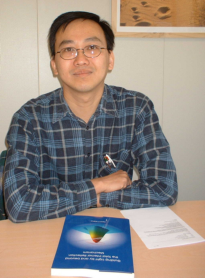Guiding Light by and beyond the Total Internal Reflection Mechanism
Promotion Date: 14 April 2005
| When we have a high index core medium we can trap the light, but recently other ways have been found: for instance in photonic crystal and anti-resonant waveguides, cladding with periodic (air) holes or layers have been used to guide light, even with a low index core. I did the modelling on those structures. If you can make the light to go in either this or that direction, in other words, if you can manipulate light, you can use it for telecommunication applications as well as a probe to measure the properties of the surroundings. We want to capture light to control it and use it for sensors, telecommunication-related circuits etc. |
What was your thesis about?
When we have a high index core medium we can trap the light, but recently other ways have been found: for instance in photonic crystal and anti-resonant waveguides, cladding with periodic (air) holes or layers have been used to guide light, even with a low index core. I did the modelling on those structures
Why is it so important to guide or capture light?
If you can make the light to go in either this or that direction, in other words, if you can manipulate light, you can use it for telecommunication applications as well as a probe to measure the properties of the surroundings. We want to capture light to control it and use it for sensors, telecommunication-related circuits etc.
My work was a study on the structures that guide light. I developed numerical methods, a mode solver by which we can calculate the structures. My mode solver is general enough to calculate various structures like photonic crystal fibres and hollow-core integrated optical waveguides.
To determine which one is the most efficient?
Not that, but a calculation to study their behaviour. Every structure has its own unique properties that may lead to a certain application.
Nobody has done that before?
It has been done before in photonic crystal fibres, but I developed the so called transparent boundary conditions to calculate the structure in a quite small computational domain. I introduced a way for people to model quite complicated structures with modest computational effort.
So your work is a great help to your colleagues that try to develop structures on a nanoscale?
Yes. And there is something I haven’t mentioned yet: when we are able to guide light in a hollow core and introduce liquids, we can have interaction between liquid and light. This might be very interesting for multi disciplinary research to initiate biological and chemical processes, as well as sensing their properties. I proposed a strategy to minimize the loss of light as it travels through integrated optical chip consisting of this hollow-core structure.
Where are you from?
Indonesia. Jakarta.
How did you arrive here?
There was a collaboration between University of Twente with the ITB (a university in Bandung), and there was a conference and workshop, in which we had to do a simulation. The organizer selected the best participants to visit the UT for three months. I was lucky to be among those. After that, I made contact with people over here and I got an offer for a Ph.D. position.
What will you do next?
I already started a post-doc job in the IOMS (Integrated Optical Micro Systems) group for another two years. Now I am going to learn to really design structures myself, whereas before I only worked on the modelling. Very interesting.
But your background is mathematics?
No, my background is electrical engineering, with a speciality in optoelectronics. So sometimes I got stuck on the mathematics, but the discussions with others pointed me in the right direction again.
What did you like best of these past four years?
Working in two groups. I enjoyed the interaction with very different people. Mathematicians, engineers, physicists, and I learned a lot from all of them. I also think that the University of Twente has a very good infrastructure for obtaining literature.
Do you have a family staying with you?
Yes, my wife and two children are here as well. We live in Enschede.
So you do not miss Indonesia too much….
Ahhh, well, the warmth, the food….
For the summary of the thesis, click here.

